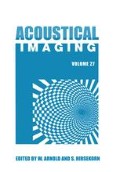Abstract
Concrete structures are continually subject to effects that degrade their structural integrity. Near surface damage in concrete may take the form of distributed microcracks or large distinct cracks that extend to the surface of the structure. Much of the damage in concrete develops at length scales that are smaller than the size of the majority of the aggregate [7]. It has been shown in [8] that diffuse (incoherent) ultrasonic methods, which make use of the scattered fields, may be viable for assessing damage in concrete. Several recent research papers [3] [6] report efforts to non-destructively determine the depth of surface breaking cracks in concrete using the elastic stress wave time-of-flight (wave velocity) techniques [5]. In these papers, the crack depth is determined if the velocity of wave propagation in the sound concrete is known and a particular wave path and wave pulse-crack interaction is assumed. The frequency in which these experiments were conducted ranges from 0 to 100 kHz. A frequency of 100 kHz corresponds to a wavelength on the order of several centimeters in concrete. In the impact-echo method [6], the user must interpret the recorded echo signals. Quality interpretation requires a user experienced in waveform recognition. In [3] the frequencies used were in the range of 0 to 70 kHz. The wave source is generated by an impact of the steel ball on the specimen surface. It is difficult to generate a high frequency waves without damaging the surface. The sensitivity to crack depths of the surface wave methods is one wavelength and hence it becomes insensitive and cannot detect deep cracks.
Access this chapter
Tax calculation will be finalised at checkout
Purchases are for personal use only
Preview
Unable to display preview. Download preview PDF.
Reference
S. K. Ramamoorthy, Y. Kane and J. A. Turner (2003). Ultrasound for crack depth determination in concrete (Under review)
P. Anugonda, J. S Wiehn, and J. A. Turner. (2001). Diffusion of ultrasound in concrete. Ultrasonics, 39: 429–435.
M. Ghandehari, K. V. Subramaniam, Jan D. Achenbach, J. S. Popovics, W.S ong and S. P. Shah. (2000). Application of surface wave transmission measurements for crack depth determination in concrete, ACI Materials journal, 97(2): 127–135.
Z. P. Bazant and J. Planas. (1998). Fracture and size effect in concrete and other quasibrittle materials, CRC press, Boca Raton.
H. A. Pederson, G. Hevin, O. Abraham and M. Campillo. (1998). Charecterization of surface cracks with Rayleigh waves: A numerical model, NDT&E international, 31(4): 289–297.
J. Ming, L. M. Sansalone and W. B. Streett. (1998). Determining the depth of surface-opening cracks using impact-generated waves and time-of-flight techniques, ACI Materials Journal, 95(2): 168–177.
S. Popovics and J. S. Popovics (1998). Ultrasonic testing to determine water-cement ratio for freshly mixed concrete, ASTM, 20(2): 262–268.
J. A. Turner and R. L. Weaver. (1995). Time dependence of multiply scattered diffuse ultrasound in polycrystalline media, J. Acoust. Soc. Am., 97(3): 2639–2644.
Author information
Authors and Affiliations
Editor information
Editors and Affiliations
Rights and permissions
Copyright information
© 2004 Springer Science+Business Media Dordrecht
About this paper
Cite this paper
Ramamoorthy, S.K., Kane, Y., Turner, J.A. (2004). Ultrasound Diffusion for Crack Depth Determination in Concrete. In: Arnold, W., Hirsekorn, S. (eds) Acoustical Imaging. Acoustical Imaging, vol 27. Springer, Dordrecht. https://doi.org/10.1007/978-1-4020-2402-3_16
Download citation
DOI: https://doi.org/10.1007/978-1-4020-2402-3_16
Publisher Name: Springer, Dordrecht
Print ISBN: 978-90-481-6652-7
Online ISBN: 978-1-4020-2402-3
eBook Packages: Springer Book Archive

